I very distinctly remember sitting in a packed room at my first Frequent Traveler University and hearing Ben Schlappig of One Mile at a Time ask by a show of hands how many people in the audience primarily used miles and points to fly business and first class. I couldn’t believe it when nearly every hand in the room shot up. I wondered what I was missing; I had never in my life flown anything but economy class and wondered why I would want to use more miles to ultimately fly less when I could use fewer miles (to fly economy) and travel more. Until that moment, despite having read some premium cabin flight reviews, I was pretty firm that I wanted to use my miles to travel more instead of more comfortably — after all, the back of the plane arrives at the same time as the front of the plane, right? Still, the proportion of hands that went up made me wonder what I was missing…..

Years (and many premium cabin flights) later, my hand would now also rise in response to that question. But there are always newcomers to the game who share the same perspective I long held: better to travel more than less and miles can make that possible. Recently, a member of our Frequent Miler Insiders Facebook group posted a question about this topic:
New to points and miles. Looking at options for international travel and while I know business class is nicer, the difference in miles for economy is tempting. So my question is how bad is economy on long haul flights? Say 8 hours. Everyone always talks about business class obviously your miles will stretch further on economy.
We often see variations on this question. The truth is that I flew plenty of 8hrs-or-longer flights in economy class in the years before I discovered points and miles. Despite the impression you might get from reading points and miles blogs, millions of people fly in economy class every year and live to tell the tale. You can certainly do that with miles (and let’s be clear: most people who book awards book economy class awards despite the hype around business and first class).
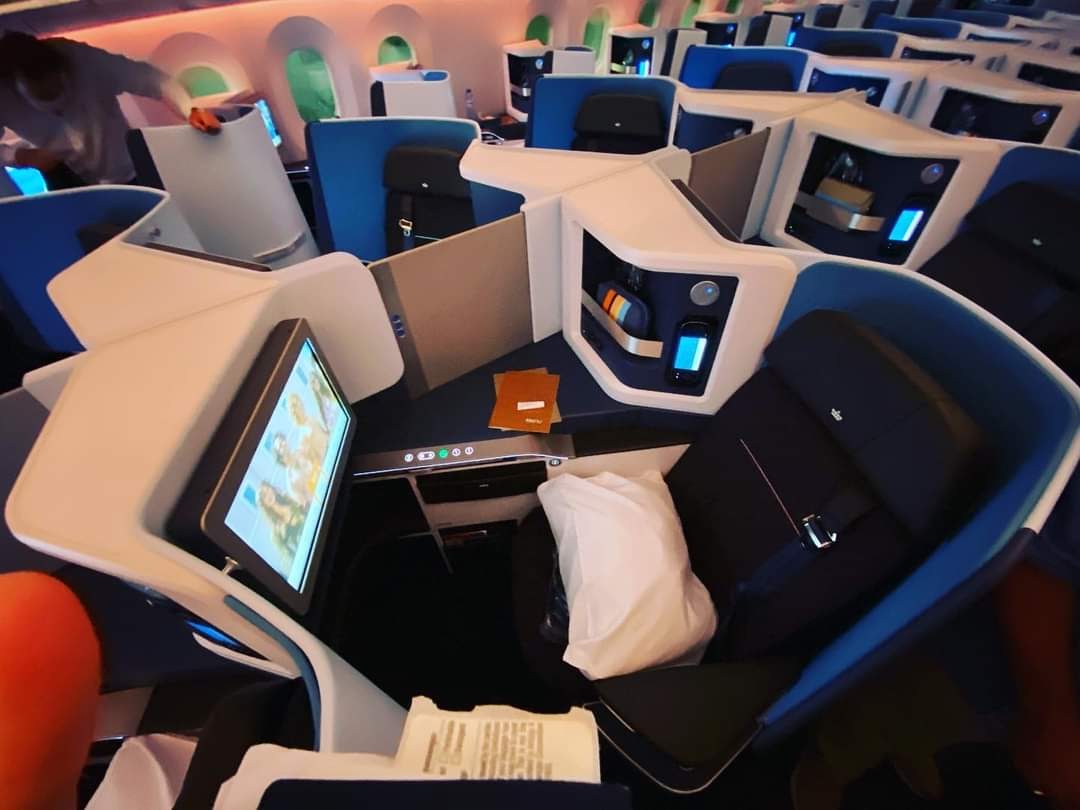
In my case, I soon after that first conference began digging deeper into award charts and sweet spots (our Best ways to get to guides provide info on many of the best sweet spots for booking awards to all of the various regions of the world) and I began realizing how easy it is to accumulate a large number of miles through credit card sign ups, shopping portals, good category bonuses, and all of the games we play.
I specifically remember looking at flight from Cairo to Tokyo using American Airlines miles. At the time, I think that at the time the economy class price for a partner award on that route was 22,500 miles one-way (to travel from the Middle East to Asia 1 – note that this award costs the same price today). Business class was 30,000 miles back before March 22, 20215 — just 7,500 miles more than flying economy class! (Today a business class award on the same route costs 40,000 miles). I distinctly remember thinking about just how far it is from Egypt to Japan and that the difference between economy class and business class was less than the cost of a one-way domestic economy class award ticket within the United States. It seemed like a steal!
The first class price on that route – *first class* – was 45K miles (today it still only costs 50K miles from the Middle East to Asia in first class). I realized that for 50% more than the business class price at the time (or double the economy class price), I could have free-flowing champagne, a chef in the sky with dine-on-demand food, a flat bed so that I could arrive fully rested and ready to hit the ground running instead of crashing at a hotel with jetlag, lounge access to eat for free at the airport, etc. I decided to try it — and I haven’t looked back since.
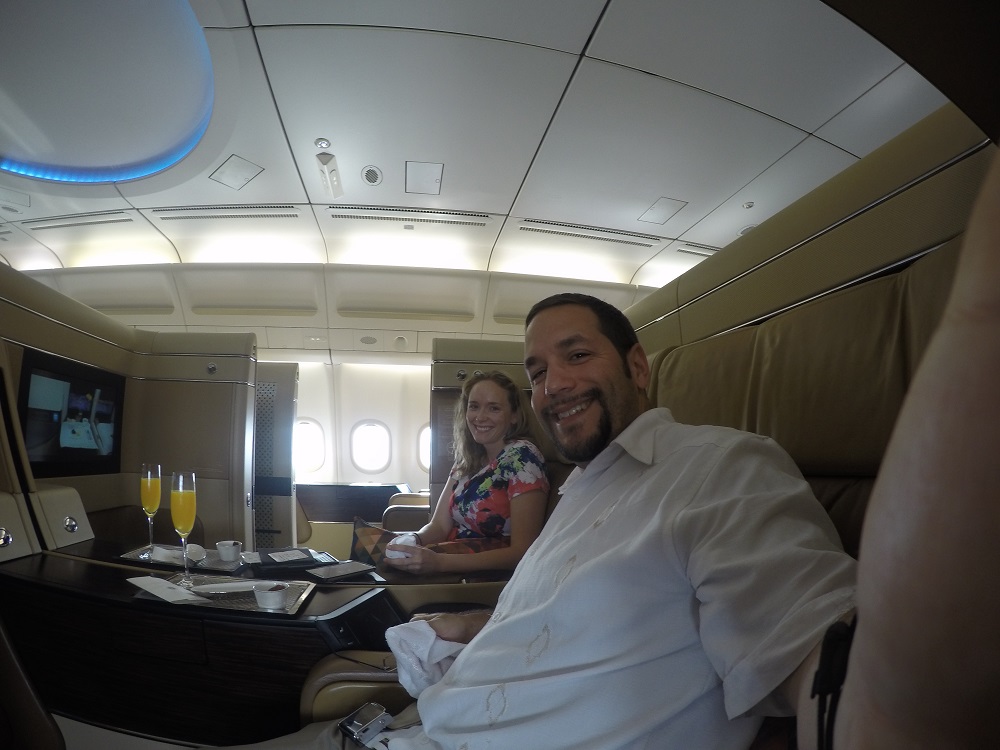
I could run the same numbers to a place like Europe and they would work out similarly. Most programs charge 25K or 30K miles one-way in economy class between the US and Europe, but you could fly off-peak business class on Iberia from east cost cities for 34K miles (See: Avios sweet spots for award travel) or use Turkish Miles & Smiles to fly Star Alliance business class for 45K (See: Turkish business class sweet spots from the US) or Virgin Atlantic to fly Delta One for 50K miles (see How to book Delta flights with Virgin Atlantic miles). Keep in mind that in two of those three examples — Avios and Virgin Atlantic — there are frequently transfer bonuses. You may be able to use even fewer transferable points than those numbers if you catch a transfer bonus (which is of course also true with the economy class redemptions).
Of key importance, the difference in the mileage cost between flying in economy and business or first is far smaller than the difference in cash cost. The gap between the price of an economy class award to Europe and a business class award to Europe can be quite small, whereas the gap between the cost of an economy class cash fare and a business class cash fare could easily be a couple thousand dollars (multiple times the cost of a cash ticket in economy class).
Yesterday afternoon, we saw an example that illustrates the gap in value when ANA suddenly released a ton of first class award space between San Francisco and Tokyo (See: ANA First Class wide open, up to 5 seats in The Suite). That space is long since gone, but it provides a good example.
Those first class seats were bookable with 55,000 Virgin Atlantic points one-way (and about $450 in surcharges one-way or $730 round trip).
By contrast, most airline programs charge around 40,000 miles each way for economy class awards between North America and Asia. The cheapest one-way economy class awards of which I am aware would cost 25K miles one-way. However, on an example date used in my post yesterday (May 10th), American Airlines was charging 56,500 miles one-way in economy class.
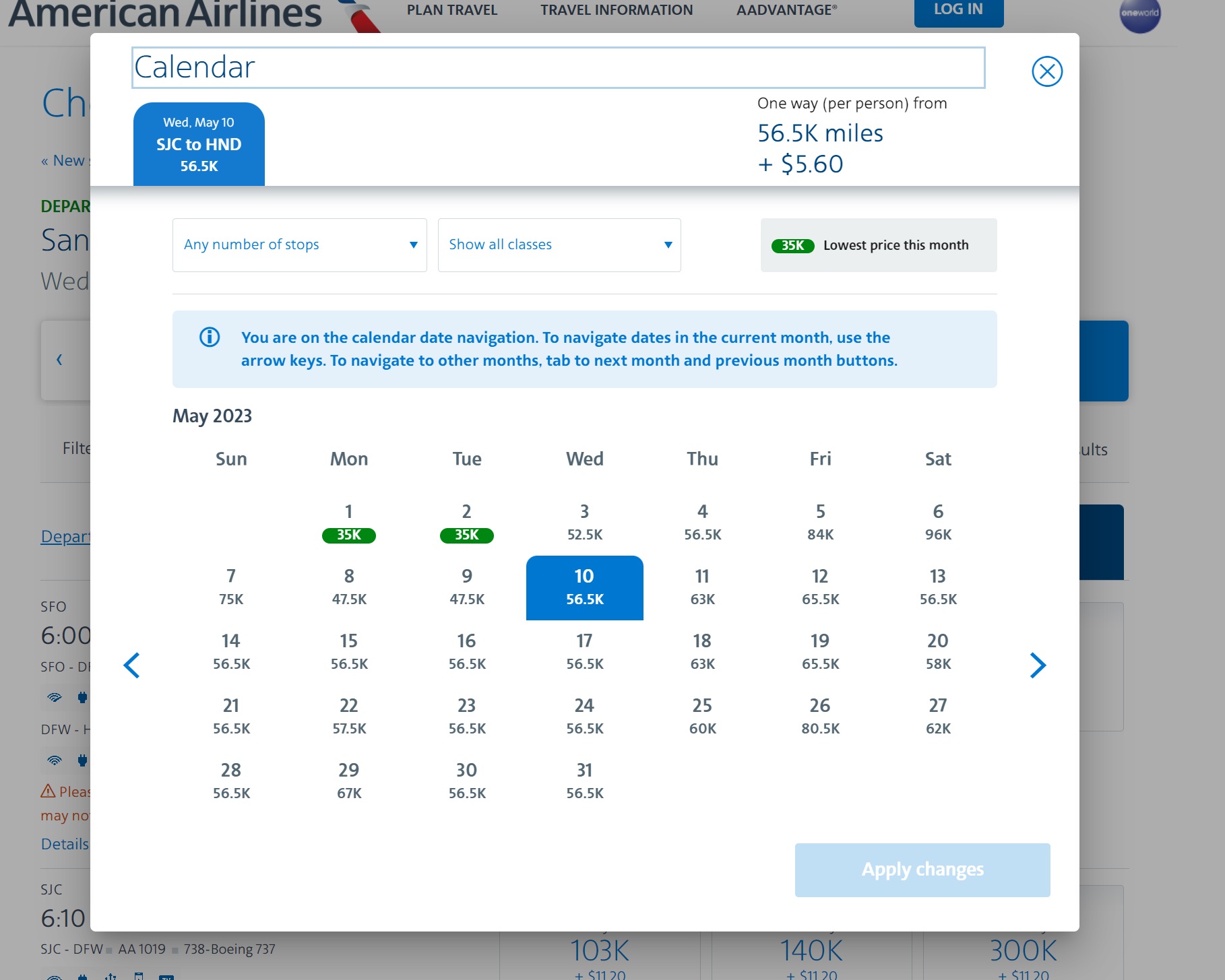
Alternatively, the cheapest one-way economy class flights on the same day were around $400.
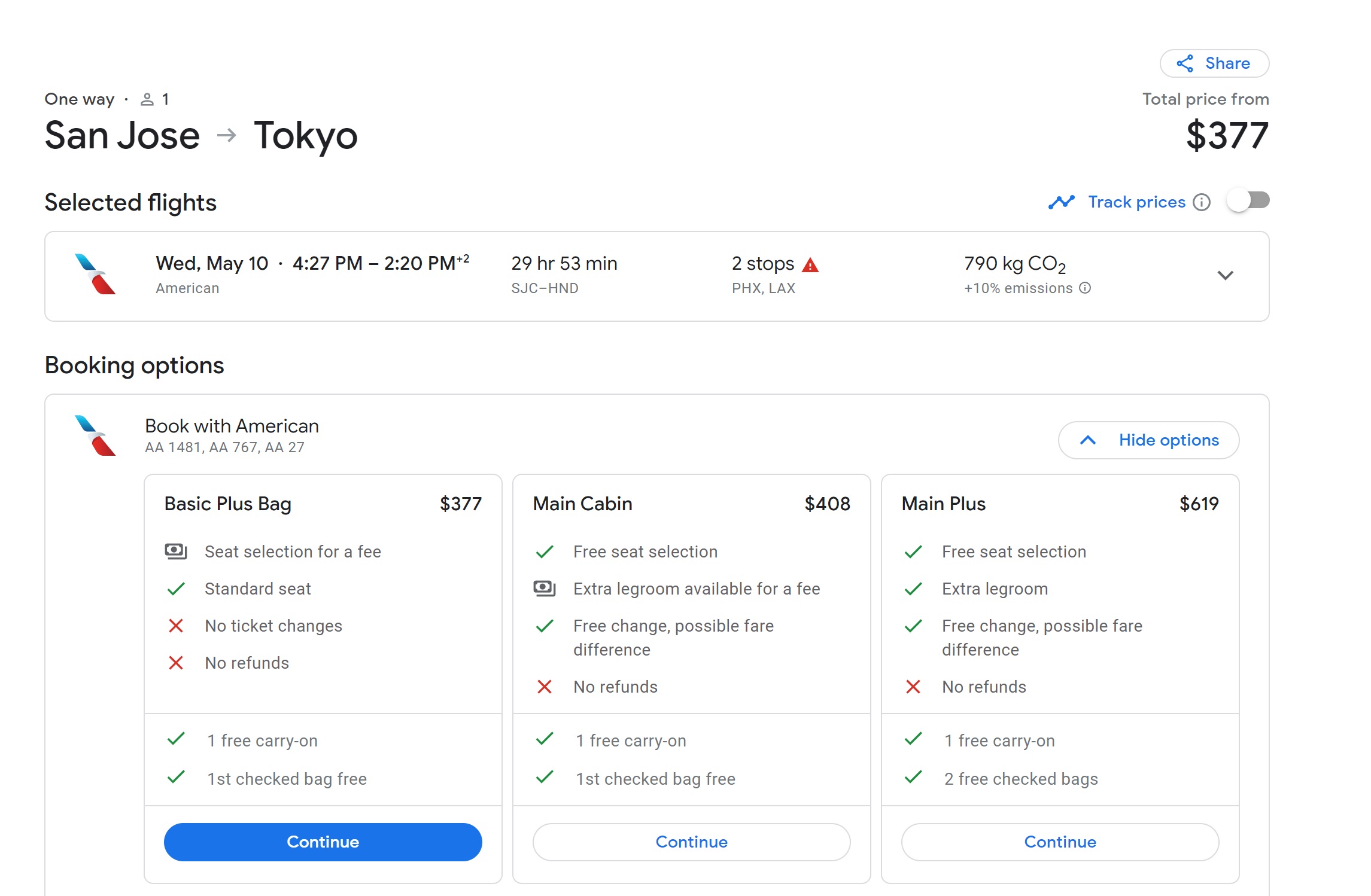
If we compare the main cabin price of $408 against American’s cheapest economy class award price of 56,500 miles on that date, it only yields a value of 0.7c per mile. Even on the days where American is only charging 32.5K miles one-way, assuming that the cash prices were the same and that we would compare against the “main cabin” fare, you’re still only looking at a value of 1.26c per mile. If you get really lucky and they have released partner availability, you could book it via Etihad Guest at 25,000 miles one-way, yielding 1.6c per mile. That’s not necessarily bad if you earned the majority of your miles from credit card welcome bonuses, but if you spent on an American Airlines credit card at 1 mile per dollar spent, it would be akin to getting just 1.26 to 1.6% cash back. You’d be better off using a 2% cash back card and using your cash back to buy a cash ticket (and earn miles!).
Again, if you’re earning the majority of your points and miles from welcome bonuses and/or good category bonuses, those values can certainly be good enough. Astute readers will recognize that if cash prices are about $400, you could alternatively book the same flights via Chase Travel℠ for around 27K Ultimate Rewards points one-way if you have the Chase Sapphire Reserve (with no need to hunt for award availability).
On the other hand, premium cabin travel offers the opportunity for far more outsized value. In my post about the ANA first class availability last night, I showed the first class price on May 10th was a bit over $12,000 one-way.
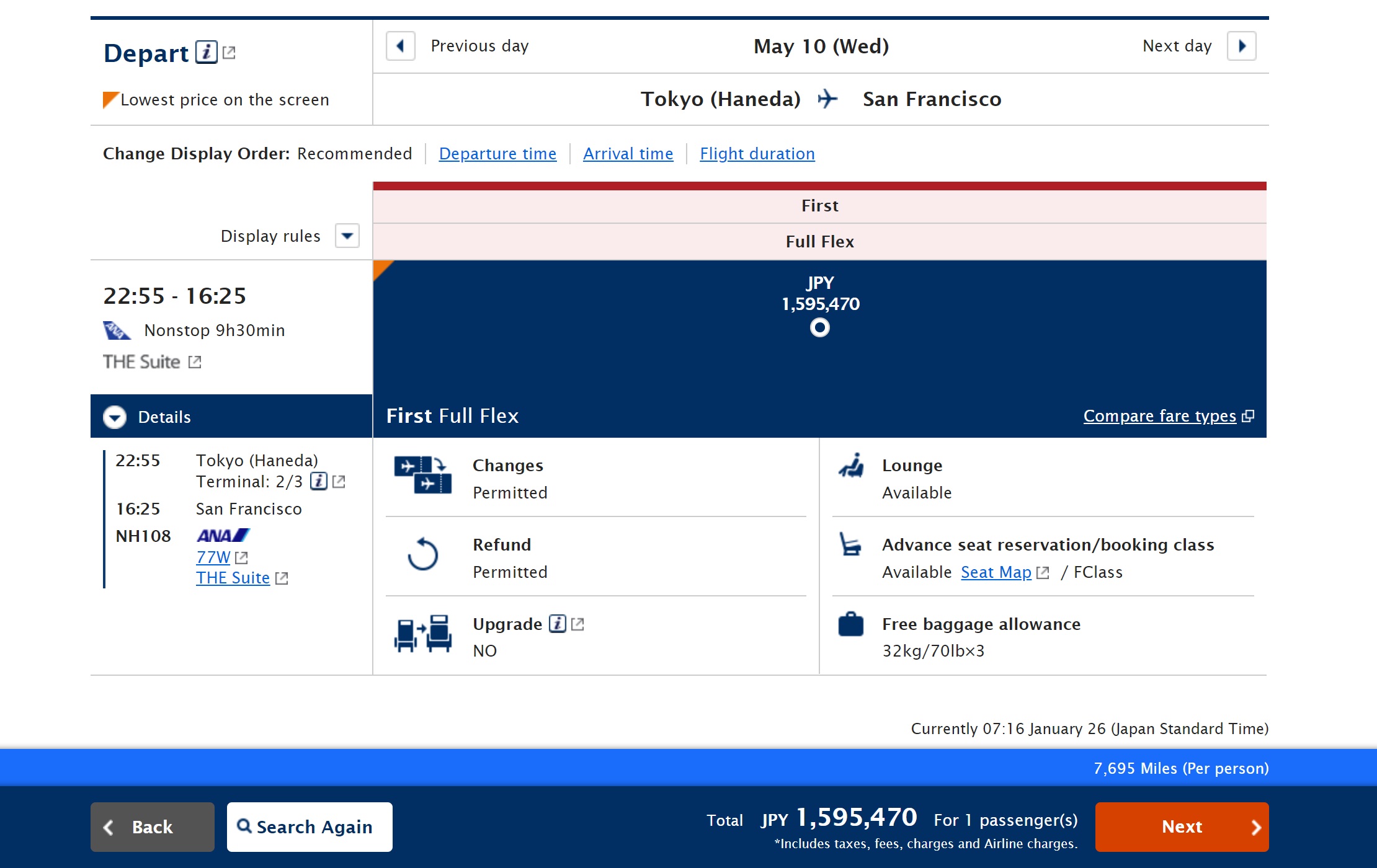
International premium cabin one-way tickets sometimes cost more than a round trip, and in truth, a round trip cash ticket was available for almost the same $12K price. Let’s therefore consider a one-way ANA First Class ticket to have a cash value of around $6,000 (about half the cost of a round trip). An award seat in first class on the same flight was available for 55,000 miles and $450. In that case, 55,000 miles was yielding roughly $5,500 in value against the cash cost of a ticket.
Of course, you shouldn’t really value a redemption like that at 10c per mile. Rather, if we value the miles at 1c per mile to keep the math simple, it’s sort of akin to paying $1,000 one-way for the first class award. Compared against ~$400 for economy class, I’d consider that to be a great deal.
Essentially, for a bit more than double the cost of an economy class award ticket, I could have an experience that I would never otherwise get. ANA is well known for excellent service, but the seat itself and its 43″ entertainment screen look amazing. They serve ~$200 champagne and on some routes whiskey that runs even more per bottle. Catering will no doubt be fantastic. Vacation will begin the moment I get to the first class check-in area at the airport and continue on to the first class lounge and for the entire flight. Let’s be clear: I don’t need $200 champagne or $500 whiskey (truthfully I’ve never even had a sip of whiskey) and I could easily fly in economy class for 11.5 hours, but for what feels like a relatively modest premium over economy class I could end up with a far more comfortable and enjoyable experience. The flight becomes part of the vacation rather than only a means of transportation.
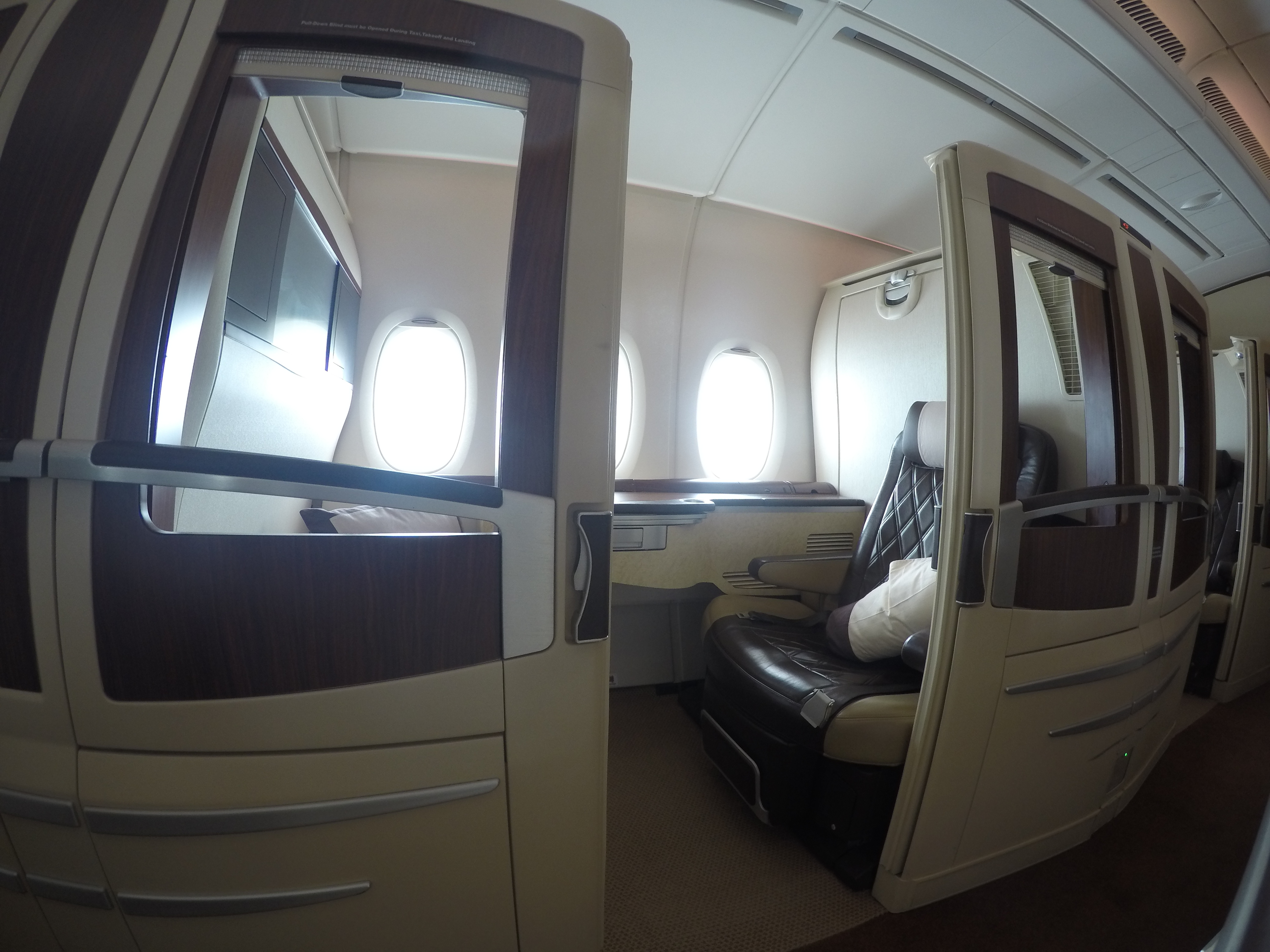
And let me reemphasize the value in arriving with a full night’s sleep and ready to go. That’s made a big difference on a lot of trips.
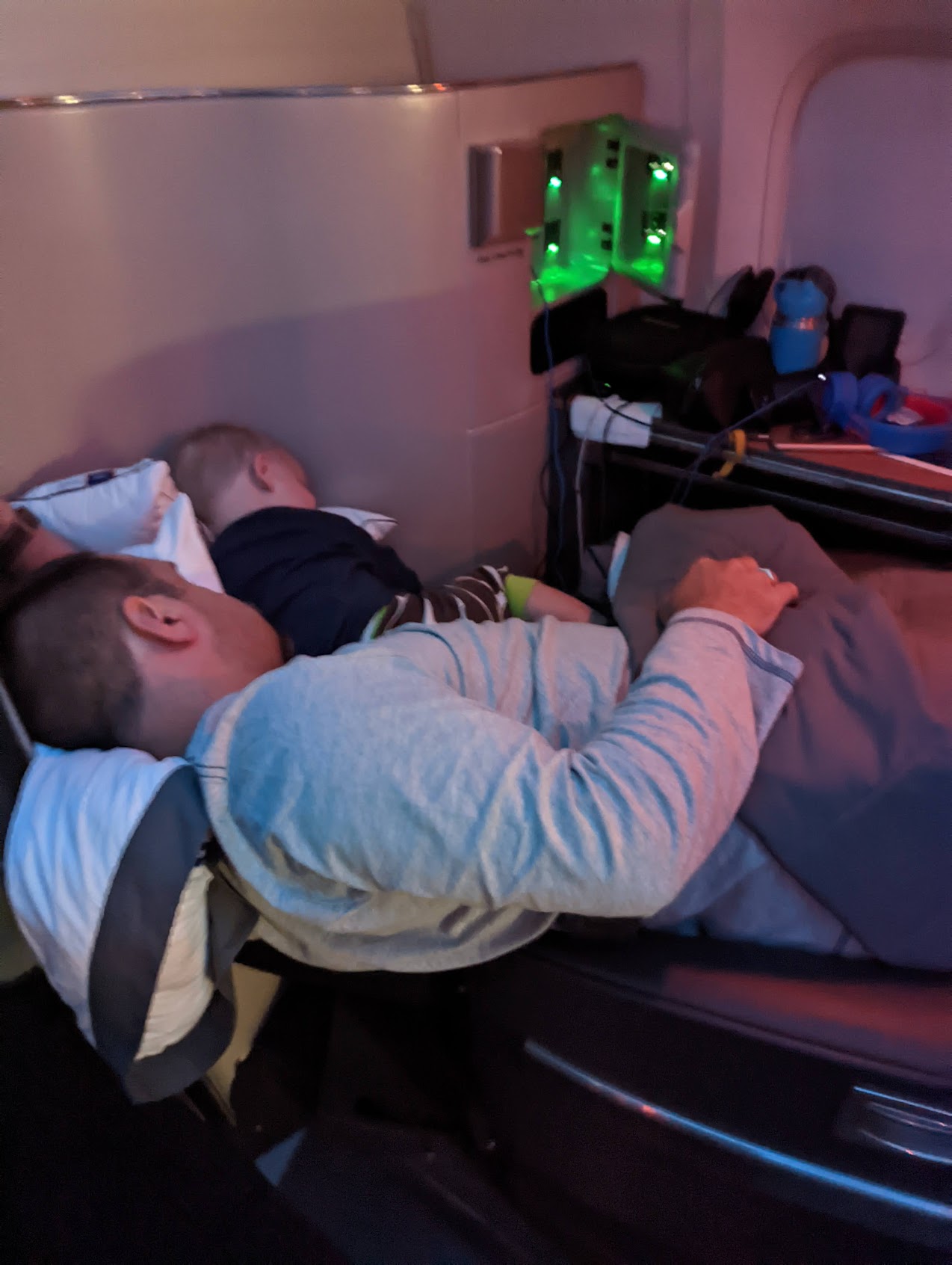
The other key is the ease of earning the miles. These past few years, Amex has been throwing out points like candy — we’ve extensively covered the incredible welcome bonuses, many with no lifetime language, and spending offers and upgrade offers, etc. Staples has (apart from one recent sale) increased the number of fee-free Visa and Mastercard gift cards you can buy each week when on sale (so you can take advantage of earning 5x), etc. By some measures, it has been easier than ever to stockpile plenty of points.
Of course my Japan example is cherry-picked in the sense that it displays massively outsized value and ANA is notorious for releasing such little premium cabin availability. And if my starting airport were somewhere in the middle of the country, I would need to consider the additional cost of positioning to/from San Francisco and I’d be comparing against a significantly increased cash price for an economy class ticket. And for more obscure / difficult to reach destinations, economy class prices can climb into the thousands — yielding far more value per point used for those economy class awards. At the same time, the ANA example is a perfect example of how hoarding points and cherry picking awards can yield massive value. It’s a great immediate example of how being “on the hunt” and ready to stick and move when the time is right can reward you with incredible redemptions.
The bottom line is that redeeming for economy class is the most popular way to use miles and points. And if you travel with a family, it can be far easier to find availability for multiple passengers in economy class. And at least from my perspective, if my choice were to redeem miles for economy class flights or not travel at all, you would find me in economy class (just as you would have en route to the 50+ countries I visited before I knew anything about miles and points).
On the other hand, armed with things like our Best Ways to Get to guides and Greg’s post yesterday full of hacks to reduce the cost of awards even further along with strategies for earning as many miles and points as possible, the gap between the cost of economy class and business class awards can be reduced considerably. Many of us who redeem miles and points for travel find the comfort and quality of experience of premium cabin travel to be worth ~double the cost of economy. While I would never dream of paying 4x or 8x or 10x the cost of an economy class ticket (or more), and certainly not for my family of four, I get a thrill from cherry picking the best awards and striking while the iron is hot (as it was yesterday afternoon). If you play those games, you can get amazing value out of premium cabin international travel. That’s not at all to say that redeeming for economy class travel is the “wrong” way to play the game — on the contrary, if it means more travel or the difference between traveling and not, I would say that economy class redemptions are a clear “win”. But by far the most outsized wins come leveraging sweet spots like that ANA example yesterday to get the most incredible premium cabin redemptions for the best price possible. That’s not at all what attracted me to this game, but it has been what has kept me on the field day in and day out, excited to continue playing the games we play.


[…] Maximizing Mile Earnings […]
I think the way to evaluate the difference between an economy or premium redemption on given route is to calculate it based on what you value the miles at. The cash price is irrelevant to me as I would never consider paying cash. it just isn’t in the equation at all (except for rare dramatical specials). If I value a given mileage currency at 2 cents, for the sake of round numbers. and a given redemption is 25,000 in economy or 60,000 in premium, then I’m committing $375 worth of miles against $900. Would I pay $525 for the difference in comfort, service and amenities? Probably not. I’m still in the “make a lot of trips” category, as I have about four months a year I can travel and want to go lots of places.
I said 2 cents, then calculated at 1.5. Numbers should be $500, $1200 and $700
Nick, get more to the point. Your article just rambles on and on. You guys would be so much more effective if you were more concise and articulate.
Also, the podcast is so drawn out, it’s unbearable to listen to. That being said, you guys are great. Keep up the good work, all constructive criticism aside.
I think that’s too harsh. And clearly I’m not alone in appreciating Nick’s long form articles.
That said, they are quite demanding pieces. If I were Nick, I’d put a short abstract–maybe a couple of paragraphs tops–at the beginning of pieces like this. That would help all readers, and especially those with less time or attention span, to benefit from them.
My wife & I took my first international premium cabin flight in 2013 (Cathay in first) & we have been exclusively in biz on every intl trip since, usually once a year. Now that I have 2 kids though its getting harder & harder to find 4 seats and my routings are getting sillier. I’ve started to question if its worth it take a positioning flight, have a long or overnight layover, when I could fly direct in econ. Is the comfort on an 8-10 hour overwater flight worth it if it adds 10+ hours of positioning & layovers to your routing? This summer i was booked in biz IST-DUB (2 day stopover) DUB-YYZ-YVR-SEA. There are direct flights from IST & DUB to SEA. I had to ask myself why i was doing such a ridiculous routing just to be in biz on a daytime flight. Luckily, I was able to change last minute to IST-FRA-SEA, which made sense. Trying to realize that just b/c i can find a routing in biz, doesn’t mean i should fly it!!
Fine perspective for someone like me, who’s been knee-deep in First/Business class for point for years now (Thank You !FM!). One OBJECTIVE perspective to judge cost/value per airline mile for 1st/biz vs. econ that i have never seen done is based the actual cost to an airline for moving a passenger from A-to-B that simply comes down to this formula: (1) space volume per passenger and bags (0 bags basic fare vs ≤3 bags) and extra aisle space per passenger in upper classes + (2) weight per passenger including baggage (0 lb. basic fare vs ≤150 lbs) + (3) overhead costs pro-rated on variable costs (i.e., (1) volume + (2) weight). My guess is that for international flights seat volume is roughly 3 econ passengers to 1 biz passengers. Yet, often miles required for biz class typically cost 2 biz to 1 econ. FF miles value is much better for biz class than econ.
Great article. I thoroughly enjoyed reading it and all the comments, I, found it all very informative But I can’t help but being a little disappointed, I always saw you, Nick, as the one in the Frequentmiler duo who spoke to the more cost-conscious less luxury chasing readers. I guess we still have Dr Pepper.
For me, part of a young couple who is focused on saving, even covering part of an economy ticket through say, using flying blue promo awards, is a lot of value to me because that’s $500 more we have to use to spend on food and experiences. I know that I could get business to Europe for 15000 more points each way, but that’s a bunch of hotel stays that I’m also saving on.
How can I attend this Frequent Traveler University?
I am preparing for a possible trip in economy to Japan in March. Still hoping that better award seats might be released last minute, but we are not canceling the trip if we don’t get better seats. That’s the breaks. Japan has been really tough finding award seats.
On the other hand, I don’t need business for Europe anymore. P2 does not sleep on planes, so we go for the economy+ seats in the middle 3 seats. Each of us takes the aisle seat, hoping that the middle seat flies empty. That has worked for us on 2 trips. But overnight flights that are longer than 10 hours, I really want lie flat. But I can do the return in PE. It just depends on the destination and the airline. From ORD international non-stop award seats are easier to find than the East or West coasts airports. So no need for me to fly to SFO/LAX and deal with a positioning flights. Which considering all the delayed flights lately, I’d rather be on the non-stop from ORD.
What route would that be? What are you using to book award flights?
ORD>HND and return. Used Alaska miles on JAL out and return is on United.
Millions of people do fly economy and live to tell about it. But is that really a life worth leading?
Pass the caviar, please.
I have 2 kids and I don’t want them to think that the only way to travel is on lie flat seats. Flying long haul in economy is part of a life lesson. Most people are not fortunate enough to be able to afford even that. That doesn’t mean to never fly J/F but I don’t want that to be the norm.
Put those kids in economy and wave back athem from time to time.
Just make them fill out a bunch of pretend credit card applications first. Then they’ll understand the amount of work involved.
My reasons can basically be encapsulated by your fourth-to-last paragraph – because I can spare the points.
I’m not a digital nomad, nor a creative. I have a normal job in an industry with a stalwart culture, and generous, but ultimately finite PTO. All that to say, there’s a cap in how many times I head out on a long-haul trip per year to begin with. On those flights, I sometimes paid for a premium cabin before I took points and miles seriously. Now, sometimes I’ve even replenished a good number of the points I spent by the time I take the trip, so why wouldn’t I?
On my more frequent, short-haul domestic trips, I’m less concerned about premium cabin travel as much as I am greasing the wheels of getting through the airport via expedited security and perhaps lounge access delivered through credit card benefits. Partly because the difference in cabin is negligible to me on those segments, but mostly out of necessity because I live in an air market utterly dominated by Southwest anyway.
Nick, I’m in the process of getting Caesars diamond status through Wyndham match in order to try and get a “free” cruise and I was wondering if when I get Caesars diamond can I see if MGM will match to gold? I read on the internet to just take my Caesars card to an MGM and ask but there are no MGM casinos nearby where I live and I would have to make a trip to Las Vegas to do so. I don’t want to waste my time on a trip if there’s not at least a good chance that I will succeed. I want MGM gold because I read your post where it said it would increase my likelihood of getting the “free” cruise offers if I had status with more than one casino brand.
MGM only allows a free cruise for Noir and Platinum. Caesars Diamond matches to MGM Gold. So no free cruise for Gold. You might get an on-board credit of $125.
Yeah, I guess I wasn’t clear. I want to submit both Caesars Diamond status and MGM gold status to Carnival cruises. I’ve read online that the more statuses you submit the better chance of getting a “free” cruise.
Caesars partners with Carnival. MGM partners with Celebrity and Royal Caribbean. MGM at the Gold level only offers an on-board credit. Whereas Caesars offers many more cruises. Usually only paying taxes and fees. It is not “free” like you state. I get the offers all the time from Carnival, but I have taken one yet. I am a retired airline employee so I get huge discounts on all cruise lines. Meaning that I am a little more picky. Just a little recommendation, Celebrity out of the 3 lines mentioned offers the best food. Royal Caribbean offers the biggest and best “featured” ships. Also using Virgin miles, you can also book “free” cruises thru Virgin Red.
If I am flying to London, I try to book business because I want to sleep since it is a night flight. But coming back, I book premium economy; I find it much better than economy and since it is a day flight I don’t need a lie flat seat. You didn’t mention premium economy in your article. I find it is often a great alternative.
Same here, totally agree and my normal strategy.
That’s making more sense lately. For a long time, and still on some airlines (ahem, United), the difference between premium economy and business on miles has been be trivial, and many times business is cheaper!
If there weren’t devaluations, I would say that it might best to fly more economy flights, but with devaluations being common, I am trying to enjoy first/business class while I can.